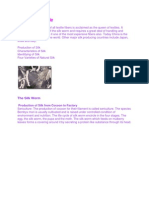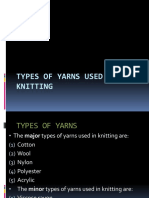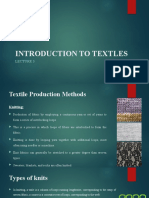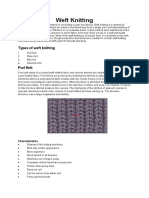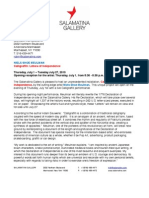Silk
Silk
Uploaded by
shevy101Copyright:
Available Formats
Silk
Silk
Uploaded by
shevy101Copyright
Available Formats
Share this document
Did you find this document useful?
Is this content inappropriate?
Copyright:
Available Formats
Silk
Silk
Uploaded by
shevy101Copyright:
Available Formats
Silk Fabric
Silk counts to the strongest natural fabric in the world. Known for its softness, luster, beauty and luxurious look, silk fabric is one of the higher grade fabric providing comfort to the wearer in all types of weather. Keeping the body cool in summer and warm in winter, silk was discovered during 2640 B.C. in china. Today there are different variety of silk available in the market like Chiffon, Georgette, Organza, Crepe de Chine, Duponi, Noil, Pongee, Shantung, Tussar, etc. Because of its sheer variety of designs, weaving and quality, Indian silk textile are popular worldwide.
Mulberry (Bombyx) silk
Natural History of Silk There is an important difference in origin and structure between wool or hair on the one hand and silk on the other. Wool and hair are formed of the protein keratin and grow either continuously or seasonally from the outer dermis or skin layer of mammals such as sheep and goats. Silk is a different protein fibroin that is produced on demand from special silk glands of several different groups of
invertebrate animals including silk moths and is extruded through openings called spinnerets in a process similar to the production of rayon. Spiders use this silk to spin a spiders web, silkworms spin a protective cocoon for the vulnerable pupa stage. Silk is produced by many insects and by spiders but commercial silk comes from caterpillars (larvae or silkworms) of silk moths of the superfamily Bombycoidea. Several different groups of silk moths are currently used to produce wild silk but cultivated silk from larvae of the Mulberry Silkworm moth, Bombyx mori, accounts for most commercial production. Bombyx mori appears to be descended from the wild silk moth Bombyx mandarina which is very widely distributed in China and Japan, also feeds on mulberry of which it considered a pest, and which crosses readily with B. mori (Aruga, 1994). The female moth is short-lived and produces about 500 eggs in 4-5 days before dying. Like almost all members of this group, it has no proboscis and does not feed. The larva, however, feeds voraciously on mulberry leaves for about 35 days before reaching full size, in optimum conditions of temperature and food quality. It then spins a silk cocoon so that it is protected whilst changing into an immobile pupa stage and then developing to an adult moth inside the pupa. The silk is produced as a thick sticky liquid through the openings of two spinnerets under the mouth and solidifies in the air to form twin filaments of silk that are glued together into a single thread with sericin. Up to a thousand metres of this silk fibre may be produced in a three day period. The pupae are generally killed by dropping the cocoons into boiling water which also dissolves the sericin coating and frees the fibre. Top of page Types of Silk Tussah silk Tussah silk is a textured wild silk produced by wild silk worms living naturally in tropical or semi-tropical forests in China and India and the cocoons are gathered after the moth emerges. The silk is beige to brownish toned possibly due to tannin from the variety of trees eaten by the caterpillars. The typical honey colour may be produced where the larvae feed on oak leaves.
Dupion, habotai and noil are qualities of silk. Dupion is an irregular, rough silk that occurs when two silk worms spin cocoons side-by-side. This results in interlocked fibres, making it necessary to reel them together, and produces a slub that gives the finished fabric a textured effect and reflective lustre. Dupion is the most widely known silk and is often used for wedding dresses etc. Habotai means soft as down or soft as a feather in Japanese and is a medium weight, ivory Chinese silk that is used for silk painting and for scarves or cushions. Noil is the short fibre left over from combing wool or spinning silk. As noil is a shorter fibre, fabric made from noil is weaker and considered less valuable.
Silk noil
Mawata silk hanky
Tussah noil
Mawata silk caps and silk hankies The cocoons are soaked in warm, soapy water and stretched over a frame that is square (approx 25 cm square) for hankies. Caps are stretched over a bamboo framework that is shaped like a knitted cap. Several cocoons are stretched over the frame so that each hankie or cap is composed of several layers, each containing the silk fibres of one cocoon. Mawata is Japanese for spread out and refers to the expansion of the cocoon. For more on Mawata, see Wormspits page on Mawata and Llyn Paynes article.
This stage is called cocoon, the desirable stage for the silk producers.
Filature operations: The cocoons raised by the farmer are delivered to the factory, called a filature, where the silk is unwound from the cocoons and the strands are collected into skeins. Some cocoons are scientifically bred in such factories. The filature operations consist of the following stages.
a) Sorting cocoons : The cocoons are sorted according to the color, size, shape and texture as these affect the final quality of the silk. Cocoons may range from white and yellow to grayish. b) Softening the Sericin : Silk filament is a double strand of fibroin, which is held together by a gummy substance called sericin or silk gum. After the cocoon has been sorted, they are put through a series of hot and cold immersions, as the sericin must be softened to permit the unwinding of the filament as one continuous thread. c) Reeling the filament : Reeling is the process of unwinding the silk filaments from the cocoon and combining them together to make a thread of raw silk. As the filament of the cocoon is too fine for commercial use, three to ten strands are usually reeled at a time to produce the desired diameter of raw silk which is known as "reeled silk". The useable length of reeled filament is 300 to 600 m. d) Bailing : The silk filament is reeled into skeins, which are packed in a small bundles called books, weighting 2 to 4.5 kg. These books are put into bales weighing about 60 kg. In this form raw silk is shipped to silk mills all over the world.
The Making of Silk Fabric:
The process of making silk is delicate and involves a number of steps.
o o o
The first stage is called sericulture. This is the cultivation of the silk worms. The most popular species for obtaining mulberry silk is Bombyx mori. The worms are raised in a controlled environment and are fed mulberry leaves. The worms form a cocoon around themselves by secreting a protein from the top of their head. The farmers collect these cocoons and deliver them to the factory, where they are subject to filature operations.
o o o o o
The first step is to sort the cocoons according to color, size, shape and texture. Then, the cocoons are made to go through a serious of hot and cold immersions. In this way, the sericin (the gummy substance that holds the fibroin strands in the silk filament together) is softened. Once this is done, the filament is unwound from the cocoon and combined to produce a thread of raw silk. This is the process of reeling. Usually, three to ten strands are reeled at a time. Finally the skeins into which the filament was reeled, are packed into bundles called books which are then put into bales to be exported to the mill. In the mill, the silk fiber is woven into silk fabric, using either a hand loom or a power loom.
Sericulture, or the raising of silkworms, involves the incubation of the tiny eggs of the silkworm moth until they hatch and become worms. After hatching, the worms are placed under a layer of gauze, on which is spread a layer of finely chopped mulberry leaves. For six weeks, the worms eat almost continuously. At the end of this period, they are ready to spin their cocoons, and branches of trees or shrubs are placed in their rearing houses. The worms climb these branches and make their cocoons in one continuous thread, taking about eight days for the process. The amount of usable silk in each cocoon is small, and about 5500 silkworms are required to produce 1 kg (2.2 lb) of raw silk.
After the complete cocoons have been gathered, the initial step in silk manufacture is to kill the insects inside them. Thus, the cocoons are first boiled or treated in ovens, killing the insects by heat. The silk fiber is obtained from the cocoons by a delicate process known as reeling, or filature. The cocoons are first heated in boiling water to dissolve the gummy substance that holds the cocoon filament in place. After this heating, the filaments from four to eight cocoons are joined and twisted and are then combined with a number of other similarly twisted filaments to make a thread that is wound on a reel. When each cocoon is unwound, it is replaced with another cocoon. The resulting thread, called raw silk, consists usually of 48 individual silk fibers. The thread is continuous and, unlike the threads spun from other natural fibers such as cotton and wool, is made up of extremely long fibers. Along with cocoons damaged by emerging worms used for breeding stock, the filaments from the coarse outer portion of the cocoon, which is removed by brushing before reeling, and the inner portion of the cocoon, which remains after reeling the raw silk, are mixed to produce a low grade of silk staple that is spun into yarn. The next step in the processing of silk is the twisting of one or more threads of the raw silk into a strand sufficiently strong for weaving or knitting. This procedure is called throwing. Four different types of silk thread may thus be produced: organzine, crepe, tram, and thrown singles. Organzine is a thread made by giving the raw-silk thread a preliminary twist in one direction and then twisting two of these threads together in the opposite direction at the rate of about 4 turns/cm (10 turns/in). Crepe is similar to organzine but is twisted to a much greater extent, usually between 16 and 32 turns/cm (40 and 80 turns/in). Tram is made by twisting in only one direction two or more raw-silk threads, with 8 to 12 turns/cm (20 to 30 turns/in). Thrown singles are individual raw-silk threads that are twisted in only one direction, the number of turns depending on the quality of thread desired. In general, organzine thread is used for the warp threads of materials, and tram threads for the weft, or filling. Crepe thread is employed in the weaving of characteristic crinkly fabrics, and single thread is used for sheer fabrics.
Characteristics of Silk Fiber:
Soft or Crisp Feeling: Silk fiber is quite soft and sometimes it feels crispy. Luxurious: The clothes or apparels that are made from Silk are luxurious and simply expensive. Silk is widely used in Bangladesh & India to make the traditional silk Sharee that is worn in any kind of festivals or social programs. Drapes Property is Good: Silk fiber is flexible enough and if silk fiber is used to make Silk garment than the fabric drapes well and this is why it can be tailored well too. Silk Fiber Is Very Much Thin: Silk is the thinnest amongst all the natural fibers. As it is so much thinner fiber, so silk can be used on any kind of fabric or clothes to be made. Dyeing Property is good on Silk: The average dyeing on Silk works good. Prints Well: Due to the fibers flexibility and other convenience; the silk fabric can easily be printed without any problem. Hand Washing & Dry Cleaning Is Possible: The washing fastness of silk fiber is good. One can wash the silk fabric by water and after washing the dry cleaning is possible too. Silk Creates Static Charges: The main problem of Silk fabric is that; silk creates static charges during wear or using any other purposes. In this case, silk fabric is little bit uncomfortable to use as the traditional dresses. For this reason we see; Silk is only used to make Sharee which is occasionally used by the women. Silk has no pilling problem: Silk fabric has no pilling problem. Abrasion Resistance Is Good: Silk fabric is good resistant to the abrasion. Light Fastness Is Poor: The main disadvantages of silk fiber is that; if you keep the silk fabric for the long time under the sun, then there might have a chance to lose the natural appearance of the silk fabric. So, its better to stay away for prolonged exposure to sunlight.
Properties of the silk: 1)It is versatile and very comfortable. 2)It absorbs moisture. 3)It is cool to wear in the summer yet warm to wear in winter. 4)It can be easily dyed. 5)It retains its shape and is relatively smooth. 6)It has a poor resistance to sunlight exposure. 7)It is the strongest natural fiber and is lustrous. Uses: Silk is used to make blouses, dresses, scarves, pants and ties. It can also be made into curtains, draperies, cushion covers and sofa covers.
You might also like
- Great Writing 4 Great Essays Teacher's Notes 2014 4th EditionDocument48 pagesGreat Writing 4 Great Essays Teacher's Notes 2014 4th EditionTấn Tài Võ100% (4)
- Textile: Types, Properties, Production, Uses and CareDocument25 pagesTextile: Types, Properties, Production, Uses and CareChikanma OkoisorNo ratings yet
- Denim HistoryDocument19 pagesDenim Historycc.fd.niftNo ratings yet
- தமிழ் நாடுDocument29 pagesதமிழ் நாடுராஜா MVSNo ratings yet
- Volleyball EssayDocument2 pagesVolleyball Essayapi-451575864No ratings yet
- Analysis On Jonathan Harvey's Tombeau de MessiaenDocument102 pagesAnalysis On Jonathan Harvey's Tombeau de MessiaenHollandRimeNo ratings yet
- Silk Fiber BookDocument28 pagesSilk Fiber BookMorgan Mccarty100% (1)
- How Silk Is MadeDocument8 pagesHow Silk Is Madesandeep_mittal62100% (1)
- Production of SilkDocument13 pagesProduction of SilkKUNTAMALLA SUJATHANo ratings yet
- Textile Fiber Intro PDFDocument30 pagesTextile Fiber Intro PDFmoorthy_sweety43075% (8)
- Silk Manufacturing ProcessDocument2 pagesSilk Manufacturing ProcessAjay Krishna0% (1)
- SilkDocument28 pagesSilkMusharaf Momin0% (1)
- The Benefits of The Silk Fibroin and SericinDocument2 pagesThe Benefits of The Silk Fibroin and SericinKittie CatNo ratings yet
- LinenDocument11 pagesLinennosh_2073100% (1)
- Textile Dyeing and PrintingDocument145 pagesTextile Dyeing and PrintingBadar Zaman67% (3)
- Silk Fiber - Molecular Formation Mechanism, Structure-Property Relationship and Advanced ApplicationsDocument34 pagesSilk Fiber - Molecular Formation Mechanism, Structure-Property Relationship and Advanced ApplicationsVikrant KambojNo ratings yet
- WoolDocument69 pagesWoolnitishkohli100% (5)
- NPTEL - Textile Engineering - High Performance and Specialty FibresDocument5 pagesNPTEL - Textile Engineering - High Performance and Specialty FibresbheenwaramNo ratings yet
- Food and Agriculture Organization: Salvador, Bahia, Brazil, November 15, 2011Document30 pagesFood and Agriculture Organization: Salvador, Bahia, Brazil, November 15, 2011zubairNo ratings yet
- FibresDocument78 pagesFibresnitishkohli100% (1)
- Interlacement: Weave DesignDocument7 pagesInterlacement: Weave DesignShahan AkhtarNo ratings yet
- Types of YarnsDocument16 pagesTypes of YarnsAkhilendra SonkarNo ratings yet
- Fundamentals of Textiles: Learning ObjectivesDocument30 pagesFundamentals of Textiles: Learning ObjectiveskabuNo ratings yet
- Chapter 3 Fabric Properties and Their Characteristics - Symplectic PDFDocument46 pagesChapter 3 Fabric Properties and Their Characteristics - Symplectic PDFVenu VenuNo ratings yet
- Sujani Raw MaterialDocument4 pagesSujani Raw MaterialAmisha SinghNo ratings yet
- Background of Carpet PrjectDocument22 pagesBackground of Carpet PrjectVikash RaiNo ratings yet
- Study On Textile FibersDocument9 pagesStudy On Textile FibersAbid hasanNo ratings yet
- A Guide To Calculations Relating To Yarn and Cloth and All Processes of WeavingDocument4 pagesA Guide To Calculations Relating To Yarn and Cloth and All Processes of WeavingRashique Ul LatifNo ratings yet
- Knowing Textile - Present 4Document48 pagesKnowing Textile - Present 4Aisya IsaisNo ratings yet
- Different Types of Basic Weaves StructuresDocument14 pagesDifferent Types of Basic Weaves Structuresmehak hooda100% (1)
- Spacer FabricDocument6 pagesSpacer FabricAnonymous 1pZlqV100% (1)
- Fibres To FabricDocument23 pagesFibres To FabricPallavi Luthra Kapoor100% (1)
- Introduction To TextileDocument30 pagesIntroduction To Textileumar.niift3049100% (1)
- Types of WeaveDocument14 pagesTypes of WeaveKristie LaurierNo ratings yet
- 8 WeavingDocument2 pages8 Weavingapi-300439474100% (1)
- JuteDocument15 pagesJuteAnmol JainNo ratings yet
- Textile Design Lecture 3Document15 pagesTextile Design Lecture 3Muhammad Usama WaseemNo ratings yet
- Textile PPT - I Year-Cellulosic FibersDocument58 pagesTextile PPT - I Year-Cellulosic FibersShikha Agrawal100% (1)
- TextileDocument85 pagesTextileGihan Rangana100% (1)
- Textile DictionaryDocument16 pagesTextile DictionaryRANG2812No ratings yet
- LeatherDocument12 pagesLeatherPooja Verma80% (5)
- Warp Insertion KnitsDocument17 pagesWarp Insertion KnitsPriyanshurajscribdNo ratings yet
- IkatDocument19 pagesIkatSambit MohapatraNo ratings yet
- Terry Knit FabricsDocument45 pagesTerry Knit FabricsSaumya KharyaNo ratings yet
- Ethical Issues in FashionDocument25 pagesEthical Issues in FashionAbhināvesh ŘoyNo ratings yet
- Fabric Development & SourcingDocument12 pagesFabric Development & SourcingdarkknightNo ratings yet
- Analysis of SpandexDocument11 pagesAnalysis of SpandexJuan CubasNo ratings yet
- Woven Fabrics AtiqDocument291 pagesWoven Fabrics AtiqMohammed Atiqul Hoque ChowdhuryNo ratings yet
- SEWN PRODUCTS MACHINERY AND EQUIPMENT ModelDocument8 pagesSEWN PRODUCTS MACHINERY AND EQUIPMENT ModelUjwala Jain0% (1)
- Weft KnittingDocument5 pagesWeft KnittingKIRTI PATELNo ratings yet
- Spandex FiberDocument16 pagesSpandex Fibernitishkohli86% (7)
- Fabric Construction - WovenDocument16 pagesFabric Construction - WovenKhalid Rahman Porosh100% (3)
- Classification of Leather Garments Based On Materials Design Usages and Fashion How Do You Choose Leather? The Factors That Influence The ChoiceDocument19 pagesClassification of Leather Garments Based On Materials Design Usages and Fashion How Do You Choose Leather? The Factors That Influence The ChoiceShivamNo ratings yet
- Trims and AccesoriesDocument18 pagesTrims and AccesoriesAditi Tiwari100% (1)
- What Is Silk?: Mori, Is The One Usually Used For SericultureDocument28 pagesWhat Is Silk?: Mori, Is The One Usually Used For Sericulturetex_hasan_014No ratings yet
- SILKDocument7 pagesSILKDivyanshi PrajapatiNo ratings yet
- SilkDocument10 pagesSilkShivesh DixitNo ratings yet
- SilkDocument5 pagesSilkatul kumarNo ratings yet
- SilkDocument9 pagesSilkAsif SiamNo ratings yet
- VII SilkDocument3 pagesVII Silksmi_santhoshNo ratings yet
- Production, Properties and Uses of Silk FiberDocument25 pagesProduction, Properties and Uses of Silk FibersandhyaRanimohantyNo ratings yet
- Name: Maisha Morrison Class: 1A2 School: Harmon's School of SDA Topic: Social IssuesDocument12 pagesName: Maisha Morrison Class: 1A2 School: Harmon's School of SDA Topic: Social Issuesshevy101No ratings yet
- Sir Ellis Emmanuel Innocent Clarke: 1st August 1976 To 13th March 1987Document2 pagesSir Ellis Emmanuel Innocent Clarke: 1st August 1976 To 13th March 1987shevy101No ratings yet
- Prime Ministers of Trinidad & Tobago.............................................................. 2Document7 pagesPrime Ministers of Trinidad & Tobago.............................................................. 2shevy101No ratings yet
- Processing: Wool Fabric Is Equipped With Different Characteristics Like Warm, Resists To WrinkleDocument10 pagesProcessing: Wool Fabric Is Equipped With Different Characteristics Like Warm, Resists To Wrinkleshevy101No ratings yet
- Rebar Cutting List SampleDocument7 pagesRebar Cutting List SampleAndrea MagtutoNo ratings yet
- Literature - Jevikern - Mila (Movie Review)Document2 pagesLiterature - Jevikern - Mila (Movie Review)Noel MendozaNo ratings yet
- It Was The MidDocument1 pageIt Was The MidZaara ZaveriNo ratings yet
- Complete Rite of Empowerment by The Pantheon of The SevenDocument6 pagesComplete Rite of Empowerment by The Pantheon of The SevenYuri M100% (1)
- Ni Luh Putu Ika Sintya Devi - UASDocument2 pagesNi Luh Putu Ika Sintya Devi - UASikaNo ratings yet
- This Will Make You A Good Dancer A Guide To Pole DANCINGDocument3 pagesThis Will Make You A Good Dancer A Guide To Pole DANCINGhappygirlhotNo ratings yet
- Calligraffiti Letters of IndependenceDocument2 pagesCalligraffiti Letters of IndependenceRafael IbaveNo ratings yet
- Iso 2768Document5 pagesIso 2768thanhhai130100% (3)
- 2.future Time ClausesDocument1 page2.future Time Clausesseda öztorunNo ratings yet
- Students Problems and Their SolutionsDocument3 pagesStudents Problems and Their SolutionsShafi MuhammadNo ratings yet
- The Story of The Bad Little BoyDocument3 pagesThe Story of The Bad Little BoymunirahwhNo ratings yet
- Codility Demo Solution 100%.htmDocument54 pagesCodility Demo Solution 100%.htmprasureshNo ratings yet
- Egyptian Sunset CollageDocument17 pagesEgyptian Sunset Collageapi-238721855No ratings yet
- Sign Conventions:: Lesson 8: Title: Thin Lens EquationDocument3 pagesSign Conventions:: Lesson 8: Title: Thin Lens EquationJatmiko RosindahNo ratings yet
- Gurugram - S4P W2 PDFDocument14 pagesGurugram - S4P W2 PDFITDP IndiaNo ratings yet
- Note On How To Detect Errors in MusicDocument9 pagesNote On How To Detect Errors in MusicromanrecocheteNo ratings yet
- Yeng Constantino - Salamat Lyrics - MetrolyricsDocument3 pagesYeng Constantino - Salamat Lyrics - Metrolyricsrubieann_danzalanNo ratings yet
- Volume in Drive D Has No LabelDocument3 pagesVolume in Drive D Has No LabelNavneetMishraNo ratings yet
- Spreadsheet+ Band+Document32 pagesSpreadsheet+ Band+Thomas Denson100% (1)
- Recipes: 1 PancakesDocument3 pagesRecipes: 1 PancakesFatima SadikNo ratings yet
- Rock of Ages LyricsDocument23 pagesRock of Ages LyricsPamela Casas100% (1)
- Diggin' TypographyDocument8 pagesDiggin' Typographysucih100% (1)
- Nicolaus A. Huber: An Ho Lderlins Umnachtung': Cornelius SchwehrDocument12 pagesNicolaus A. Huber: An Ho Lderlins Umnachtung': Cornelius SchwehrfedoerigoNo ratings yet
- ACTIVITY 3 The MicroscopeDocument4 pagesACTIVITY 3 The MicroscopeBien PresasNo ratings yet
- Brand Factory ProfileDocument8 pagesBrand Factory Profilesuresh jain100% (2)
- 113 Chapter 13Document7 pages113 Chapter 13Jangjang CachoNo ratings yet







